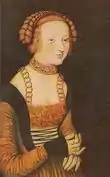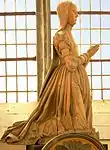1518
Year 1518 (MDXVIII) was a common year starting on Friday (link will display the full calendar) of the Julian calendar.
| Millennium: | 2nd millennium |
|---|---|
| Centuries: | |
| Decades: | |
| Years: |
| 1518 by topic |
|---|
| Arts and science |
|
| Leaders |
|
| Birth and death categories |
| Births – Deaths |
| Establishments and disestablishments categories |
| Establishments – Disestablishments |
| Works category |
|
| Gregorian calendar | 1518 MDXVIII |
| Ab urbe condita | 2271 |
| Armenian calendar | 967 ԹՎ ՋԿԷ |
| Assyrian calendar | 6268 |
| Balinese saka calendar | 1439–1440 |
| Bengali calendar | 925 |
| Berber calendar | 2468 |
| English Regnal year | 9 Hen. 8 – 10 Hen. 8 |
| Buddhist calendar | 2062 |
| Burmese calendar | 880 |
| Byzantine calendar | 7026–7027 |
| Chinese calendar | 丁丑年 (Fire Ox) 4214 or 4154 — to — 戊寅年 (Earth Tiger) 4215 or 4155 |
| Coptic calendar | 1234–1235 |
| Discordian calendar | 2684 |
| Ethiopian calendar | 1510–1511 |
| Hebrew calendar | 5278–5279 |
| Hindu calendars | |
| - Vikram Samvat | 1574–1575 |
| - Shaka Samvat | 1439–1440 |
| - Kali Yuga | 4618–4619 |
| Holocene calendar | 11518 |
| Igbo calendar | 518–519 |
| Iranian calendar | 896–897 |
| Islamic calendar | 923–924 |
| Japanese calendar | Eishō 15 (永正15年) |
| Javanese calendar | 1435–1436 |
| Julian calendar | 1518 MDXVIII |
| Korean calendar | 3851 |
| Minguo calendar | 394 before ROC 民前394年 |
| Nanakshahi calendar | 50 |
| Thai solar calendar | 2060–2061 |
| Tibetan calendar | 阴火牛年 (female Fire-Ox) 1644 or 1263 or 491 — to — 阳土虎年 (male Earth-Tiger) 1645 or 1264 or 492 |

Tropical ants devastate crops on Hispaniola.
Exceptions
France
In France, the year 1518 lasted from 4 April 1518 to 23 April 1519. Since Constantine (around year 325) and until the year 1565, the year was reckoned as beginning at Easter. For instance, the will of Leonardo da Vinci, drafted in Amboise on 23 April 1519, shows the legend "Given on the 23rd of April of 1518, before Easter".[1]
- See Wikisource "1911 Encyclopædia Britannica/Easter"
Events
January–June
- April 18 – The widowed Sigismund I the Old, King of Poland and Grand Duke of Lithuania, marries Milanese noblewoman Bona Sforza in Wawel Cathedral and she is crowned as Queen consort of Poland.[2]
- May 26 – A transit of Venus occurs.
July–December
Date unknown
- The Rajput Mewar Kingdom under Rana Sanga achieves a major victory over Sultan Ibrahim Lodi of Delhi.
- A swarm of tropical fire ants devastates crops on Hispaniola.
- Erasmus publishes his Colloquies.
- Henricus Grammateus publishes Ayn neu Kunstlich Buech in Vienna, containing the earliest printed use of plus and minus signs for arithmetic.[4]
- The remnants of The Abbasid Caliphate (stationed in Egypt under the Mamluk Sultanate (Cairo)) hands over the title of caliph to the Ottoman Empire that had conquered Constantinople in 1453, 65 years earlier
Births

Sidonie of Saxony

Clara of Saxe-Lauenburg
- February 2
- February 7 – Johann Funck, German theologian (d. 1566)[5]
- February 13 – Antonín Brus z Mohelnice, Moravian Catholic archbishop (d. 1580)
- February 20 – Georg, Count Palatine of Simmern-Sponheim, (d. 1569)
- February 21 – John of Denmark, Danish prince (d. 1532)
- February 28 – Francis III, Duke of Brittany, Duke of Brittany (d. 1536)
- March 8 – Sidonie of Saxony, Duchess of Brunswick-Calenberg (d. 1575)
- April 22 – Antoine de Bourbon, father of Henry IV of France (d. 1562)
- July 3 – Li Shizhen, Chinese physician, pharmacologist and mineralogist (d. 1593)
- August 8 – Conrad Lycosthenes, Alsatian humanist and encyclopedist (d. 1561)
- September/October – Tintoretto, Italian painter (d. 1594)[6]
- November 26 – Guido Ascanio Sforza di Santa Fiora, Italian Catholic cardinal (d. 1564)
- December 13 – Clara of Saxe-Lauenburg, Princess of Saxe-Lauenburg and Duchess of Brunswick-Gifhorn by marriage (d. 1576)
- December 17 – Ernest III, Duke of Brunswick-Grubenhagen (d. 1567)
- December 19 – Enrique de Borja y Aragón, Spanish noble of the House of Borgia (d. 1540)
- date unknown
- possible – Catherine Howard, fifth queen consort of Henry VIII of England (b. between 1518 and 1524; d. 1542)
Deaths
- February 9 – Jean IV de Rieux, Breton noble and Marshal (b. 1447)
- May 31 – Elisabeth of Brandenburg-Ansbach-Kulmbach, German margravine (b. 1494)
- July 10 – Sibylle of Baden, Countess consort of Hanau-Lichtenberg (b. 1485)
- August 16 – Loyset Compère, French composer (b. c. 1445)
- August 27 – Joan of Naples, queen consort of Naples (b. 1478)
- November 20
- November 24 – Vannozza dei Cattanei, mistress of Pope Alexander VI (b. 1442)
- December 5 – Gian Giacomo Trivulzio, Italian military commander (b. c. 1440)
- December 27 – Mahmood Shah Bahmani II, sultan of the Bahmani Sultanate (b. c. 1470)
- date unknown
- Moxammat Amin of Kazan, khan of Kazan (b. c. 1469)
- Kabir, Indian mystic (b. 1440)
- Aruj, Ottoman corsair, brother of Hayreddin Barbarossa
- Guido Mazzoni, sculptor (b. c. 1445)[8]
- Muhammad ibn Azhar ad-Din, sultan of Adal (assassinated) (b. c. 1473)
- Basil Solomon, Syriac Orthodox Maphrian of the East.[9]
References
- The Notebooks of Leonardo Da Vinci, Oxford University Press, 1980, p.391
- "A Renaissance Royal Wedding 1518-2018". Faculty of History, Oxford University. Retrieved March 28, 2021.
- Evan Andrews (August 31, 2015). "What was the dancing plague of 1518?". History.com. Retrieved March 28, 2021.
- Miller, J. et al. "Earliest Uses of Symbols of Operation" after Cajori, F. A History of Mathematical Notations.
- Friedrich Wilhelm Bautz. "Funck, Johann". Biographisch-Bibliographisches Kirchenlexikon (in German). pp. 154–155. Archived from the original on June 30, 2007.
- Joseph Archer Crowe; Giovanni Battista Cavalcaselle (1877). Titian: His Life and Times: With Some Account of His Family, Chiefly from New and Unpublished Records. J. Murray. p. 437.
- Richard O'Sullivan (1952). Edmund Plowden, 1518-1585. Honourable Society of the Middle Temple at the University Press.
- Queen's Gallery (London, England) (1988). Treasures from the Royal Collection. Queen's Gallery, Buckingham Palace. ISBN 978-0-9513373-0-1.
- Wilmshurst, David (2019). "West Syrian patriarchs and maphrians". In Daniel King (ed.). The Syriac World. Routledge. p. 811.
This article is issued from Wikipedia. The text is licensed under Creative Commons - Attribution - Sharealike. Additional terms may apply for the media files.